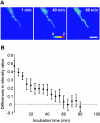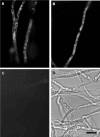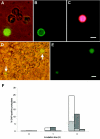Antifungal protein PAF severely affects the integrity of the plasma membrane of Aspergillus nidulans and induces an apoptosis-like phenotype
- PMID: 15917545
- PMCID: PMC1140496
- DOI: 10.1128/AAC.49.6.2445-2453.2005
Antifungal protein PAF severely affects the integrity of the plasma membrane of Aspergillus nidulans and induces an apoptosis-like phenotype
Abstract
The small, basic, and cysteine-rich antifungal protein PAF is abundantly secreted into the supernatant by the beta-lactam producer Penicillium chrysogenum. PAF inhibits the growth of various important plant and zoopathogenic filamentous fungi. Previous studies revealed the active internalization of the antifungal protein and the induction of multifactorial detrimental effects, which finally resulted in morphological changes and growth inhibition in target fungi. In the present study, we offer detailed insights into the mechanism of action of PAF and give evidence for the induction of a programmed cell death-like phenotype. We proved the hyperpolarization of the plasma membrane in PAF-treated Aspergillus nidulans hyphae by using the aminonaphtylethenylpyridinium dye di-8-ANEPPS. The exposure of phosphatidylserine on the surface of A. nidulans protoplasts by Annexin V staining and the detection of DNA strand breaks by TUNEL (terminal deoxynucleotidyltransferase-mediated dUTP-biotin nick end labeling) gave evidence for a PAF-induced apoptotic-like mechanism in A. nidulans. The localization of reactive oxygen species (ROS) by dichlorodihydrofluorescein diacetate and the abnormal cellular ultrastructure analyzed by transmission electron microscopy suggested that ROS-elicited membrane damage and the disintegration of mitochondria played a major role in the cytotoxicity of PAF. Finally, the reduced PAF sensitivity of A. nidulans strain FGSC1053, which carries a dominant-interfering mutation in fadA, supported our assumption that G-protein signaling was involved in PAF-mediated toxicity.
Figures






Similar articles
-
Characterization of the Penicillium chrysogenum antifungal protein PAF.Arch Microbiol. 2003 Sep;180(3):204-10. doi: 10.1007/s00203-003-0578-8. Epub 2003 Jul 10. Arch Microbiol. 2003. PMID: 12856109
-
The Penicillium chrysogenum antifungal protein PAF, a promising tool for the development of new antifungal therapies and fungal cell biology studies.Cell Mol Life Sci. 2008 Feb;65(3):445-54. doi: 10.1007/s00018-007-7364-8. Cell Mol Life Sci. 2008. PMID: 17965829 Free PMC article. Review.
-
Proper folding of the antifungal protein PAF is required for optimal activity.Res Microbiol. 2005 Jan-Feb;156(1):35-46. doi: 10.1016/j.resmic.2004.07.007. Res Microbiol. 2005. PMID: 15636746
-
Penicillium antifungal protein (PAF) is involved in the apoptotic and autophagic processes of the producer Penicillium chrysogenum.Acta Microbiol Immunol Hung. 2014 Sep;61(3):379-88. doi: 10.1556/AMicr.61.2014.3.10. Acta Microbiol Immunol Hung. 2014. PMID: 25261948
-
The small molecular mass antifungal protein of Penicillium chrysogenum--a mechanism of action oriented review.J Basic Microbiol. 2011 Dec;51(6):561-71. doi: 10.1002/jobm.201100041. Epub 2011 Jul 21. J Basic Microbiol. 2011. PMID: 21780144 Review.
Cited by
-
Live-cell imaging and analysis shed light on the complexity and dynamics of antimicrobial Peptide action.Front Immunol. 2012 Aug 14;3:248. doi: 10.3389/fimmu.2012.00248. eCollection 2012. Front Immunol. 2012. PMID: 22912634 Free PMC article. No abstract available.
-
Novel findings about the mode of action of the antifungal protein PeAfpA against Saccharomyces cerevisiae.Appl Microbiol Biotechnol. 2023 Nov;107(22):6811-6829. doi: 10.1007/s00253-023-12749-0. Epub 2023 Sep 9. Appl Microbiol Biotechnol. 2023. PMID: 37688596 Free PMC article.
-
Antifungal proteins: More than antimicrobials?Fungal Biol Rev. 2013 Jan;26(4):132-145. doi: 10.1016/j.fbr.2012.07.002. Fungal Biol Rev. 2013. PMID: 23412850 Free PMC article.
-
Insight into the antifungal mechanism of Neosartorya fischeri antifungal protein.Protein Cell. 2015 Jul;6(7):518-28. doi: 10.1007/s13238-015-0167-z. Epub 2015 May 22. Protein Cell. 2015. PMID: 25994413 Free PMC article.
-
Defensins: antifungal lessons from eukaryotes.Front Microbiol. 2014 Mar 20;5:97. doi: 10.3389/fmicb.2014.00097. eCollection 2014. Front Microbiol. 2014. PMID: 24688483 Free PMC article. Review.
References
-
- Arndt-Jovin, D. J., and T. M. Jovin. 1989. Fluorescence labeling and microscopy of DNA. Methods Cell Biol. 30:417-448. - PubMed
-
- Beach, J. M., E. D. McGahren, J. Xia, and B. R. Duling. 1996. Ratiometric measurement of endothelial depolarization in arterioles with a potential-sensitive dye. Am. J. Physiol. 270:2216-2227. - PubMed
Publication types
MeSH terms
Substances
LinkOut - more resources
Full Text Sources
Other Literature Sources
Molecular Biology Databases

